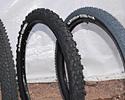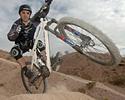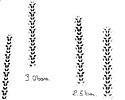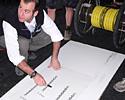
Recently on Cyclingnews.com |
Tech feature: Michelin Mountain tyre line introduction, March 2, 2007
Michelin vows return to prominence in mountain bike tyre market
By James Huang in Las Vegas, NV

|
With the exception of its superb downhill rubber, French tyre powerhouse Michelin has been a virtual non-player in the North American MTB tyre scene over the past several years. In fact, it scored its last certifiable hit way back in the late '90s with the oddly named, and distinctively colored, Wildgripper series which eventually evolved into the Comp line in the early '00s. Unfortunately, though, things have gone downhill since then, and not in a good way.
A long way down
Michelin's fall from grace may have been due to its failure to recognize the burgeoning all-mountain/trailbike/freeride categories, which now undoubtedly comprise the core of the North American MTB market. Its cross-country and downhill tyres continued to provide good performance within the racing scene, but the seemingly small 0.5" gap between its 2.0" and 2.5" casing offerings may as well have been a 30 foot road gap in terms of sales; the smaller tyres weren't durable enough and didn't offer a large enough footprint for more aggressive use, and the full DH tyres were just too heavy. Without a legitimate line of all-purpose trail tyres, Michelin simply missed the boat and was left drifting about in the current with a few neon-colored floaties.
However, with US$15.59 billion in reported net corporate sales in 2005, conventional logic would dictate that Michelin would not be content to be a B-player for very long. Indeed, Michelin has mobilized a concerted effort to regain its place of glory with a new line of tyres which the company hopes will kick start its US MTB sales by an incredibly ambitious 300% over what it does currently.
A threefold increase in sales certainly sounds awfully unrealistic, but Michelin is clearly confident in its work. The new line was launched at Bootleg Canyon in Boulder City, NV, a veritable mountain bike playground but also an area notorious for its loose corners and exceptionally unforgiving off-trail experiences (can you say, 'ouch'?).
Michelin Man to the rescue

|
Michelin tapped into its extensive off-road motorcycle experience (to the tune of eight world titles in motocross, enduro, and trials) to develop its new 'Mountain' line, which is divided into two categories, Enduro and Light Enduro. Both are aimed squarely at bikes with 130-180mm of travel and are meant to satisfy Michelin's perceived requirements for the category: toughness/durability, light weight, and traction.
The new heavier-duty 'Reinforced' Enduro casings are offered in 2.3"-2.5" sizes and include an additional bead-to-bead ply that Michelin says increases frontal and lateral impact resistance (think pinch flats and dented rims) by an impressive 50%. The additional ply brings the total number of layers located directly under the tread to four (three is the norm), which should also aid in puncture protection.
The comparatively milder Light Enduro line is available in 2.15"-2.2" sizes and maintains a standard three-ply construction, but both it and the Enduro version utilize new 60tpi thread count casings. Michelin says this provides an additional 10% in impact resistance while adding only 2.5% more weight than a more typical 127tpi count. All of the Mountain tyres also feature Michelin's High Protection Rim System (HPRS) for enhanced bead security and reduced casing wear, and select models will also be UST Tubeless-compatible.
More than just new shoelaces on old sneakers

|
Rather than cook up a set of new tread designs just for the sake of being new, Michelin has carried over its already proven patterns for both categories. The aptly-named Dry2 tread, used heavily by Adam Craig last season, is intended for dry and hard terrain with a relatively low-profile and fast-rolling knob pattern that is designed to maximize the number and length of biting edges on the ground. The multipurpose A.T. pattern features taller and more widely spaced knobs with more pronounced shoulder lugs (although there still aren't very many of them). Lastly, the X'Trem is a virtual carbon copy of Michelin's own DH 24 tread and is meant for rockier terrain with multi-directional center knobs for more traction and braking grip along with well-bolstered shoulder knobs for predictable cornering.
Michelin's Dual Compound concept carries over from last year on select A.T. and X'Trem models and still utilizes gripper rubber covering a harder core for enhanced grip and improved knob stability. Thankfully, though, a new additive is reported to significantly improve wear resistance.
So how'd they do?

|
We didn't have the opportunity to sample the X'Trem models, but we did log plenty of time on the reinforced Enduro versions of both the Mountain Dry2 2.3 and single compound Mountain A.T. 2.35 over three days of testing at Bootleg Canyon.
The Mountain Dry2 2.3 delivered surprisingly excellent (given its small knob appearance) overall cornering and drive traction on both hardpack and rock. While obviously not as light as a pure cross-country tyre, rolling resistance was minimal and braking traction was very good. After two hard days on Bootleg Canyon's super abrasive ground, the knobs were still impressively sharp as well.
The Mountain A.T. 2.35 displayed more absolute grip and a sharper overall feel with noticeably more reassuring braking response relative to the Dry2 2.3, particularly in looser conditions where the more open knob pattern would provide more bite. However, that edgier performance was also coupled with less warning of an impending slide or washout when the limits of adhesion were exceeded or when encountering loose marbles in mid-apex.
We also didn't notice any particularly detrimental effects of the Mountain A.T. 2.35's stiffer reinforced casing or its predictably slower rolling performance, but that was admittedly difficult to judge after only one day on this particular tyre on relatively unfamiliar trails. Thankfully, both tyres also measured true-to-size (or at least weren't undersized).
Sink or swim
Although long overdue, Michelin's new Mountain line is a refreshing change of pace and bodes well for the company's self-imposed sales targets. We'll see how they do on more familiar terrain later on this season, but you can rest assured that if they do even reasonably well at Bootleg Canyon, things are looking pretty good.
|
|
Dry terrain |
All terrain |
Rocky terrain |
|
Enduro |
Mountain Dry2 2.3, Reinforced |
Mountain A.T. 2.35, Reinforced |
Mountain X'Trem 2.5, Reinforced, Dual Compound |
|
Light Enduro |
Mountain Dry2 2.15 |
Mountain A.T. 2.2, single compound or dual compound |
Mountain X'Trem 2.2, Dual Compound |
Photography
For a thumbnail gallery of these images, click here
Images by James Huang/Cyclingnews.com
- Michelin officials were clearly confident in their new tire line as they launched the 2007 Mountain line at Bootleg Canyon in Boulder City, NV.
- Michelin finally fills a gaping hole in its tire lineup with a new group of all-mountain tires.
- The Mountain Dry2 delivers the same proven tread pattern as the XC version but with a wider casing.
- The Mountain A.T. is a multi-purpose tread pattern designed for mixed conditions.
- Michelin's new Mountain X'Trem takes the company's proven DH 24 tread pattern and adapts it for all-mountain use.
- This is a sight for sore eyes on a Michelin casing.
- A new bead-to-bead ply delivers greater impact and puncture resistance.
- Michelin tapped into its extensive motorcycle tire technology in developing the new Mountain casings.
Images by Manu l'Arc en ciel
- The Mountain Dry2 wears relatively shallow knobs, but there are a lot of them available for grabbing the trail.
- Testing the cornering grip of Michelin's new Mountain Dry2 2.3.
- Michelin's Mountain A.T. in mid-flight at Bootleg Canyon, NV.
Images by James Huang/Cyclingnews.com
- Tires were mounted up on a fleet of Giant Reign X and Lapierre X-160 and X-Control 130 test bikes.
- The Lapierre X-160 offers up outstanding suspension performance, but unfortunately is not available in the US.
Images by Manu l'Arc en ciel
- Snaking up the trail at Bootleg Canyon.
- Nicolas Vouilloz hard at work.
- While best known as a XC racer, Adam Craig is equally skilled going downhill as well as up.
- Adam Craig has been piloting the Dry2 tread since last season.
- Nicolas Vouilloz's tire of choice during testing was the Michelin Mountain A.T.
Images by James Huang/Cyclingnews.com
- Vouilloz is known for running atypically lightweight equipment considering the type of riding he does. However, Vouilloz is so smooth on the bike that he simply does not subject his parts to as much abuse as much of his competition.
- Vouilloz runs a Dura-Ace triple crankset with 30/42T rings and a custom-made carbon fiber outer chainguide.
- Michelin mountain bike tire designer Olivier Godrie explains the effects of inflation pressure on a tire's contact patch.
- Michelin's contact patch test sled can be fitted with various amounts of weight to simulate loads.
- Tire pressure can have a profound effect on a tire's contact patch. Note the changes in this Michelin Dry2 as pressure is decreased from left to right.



